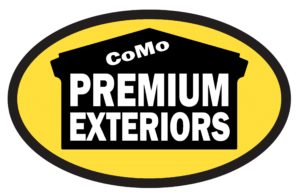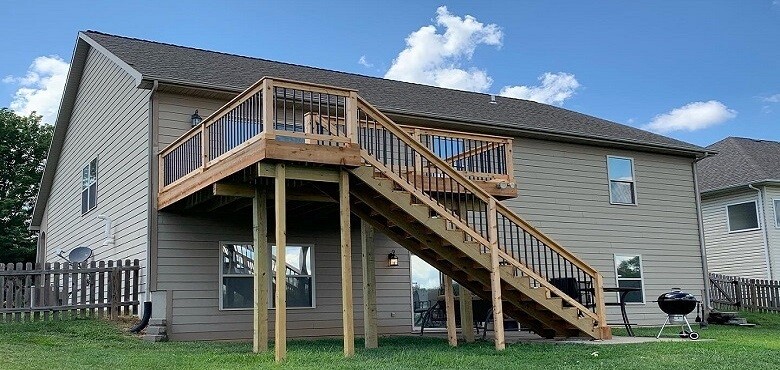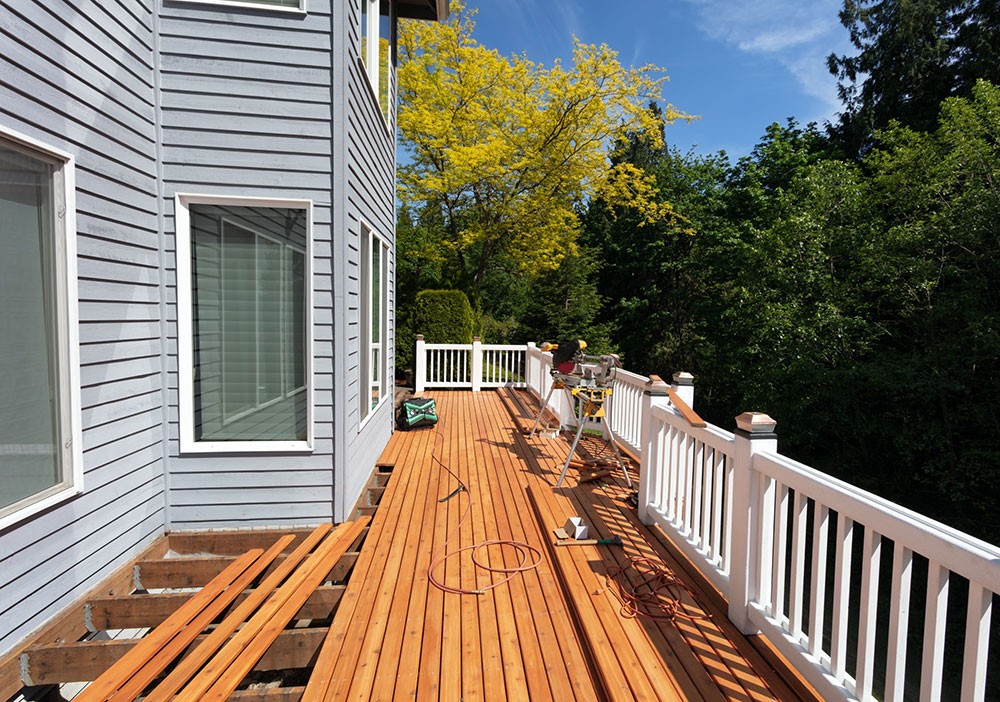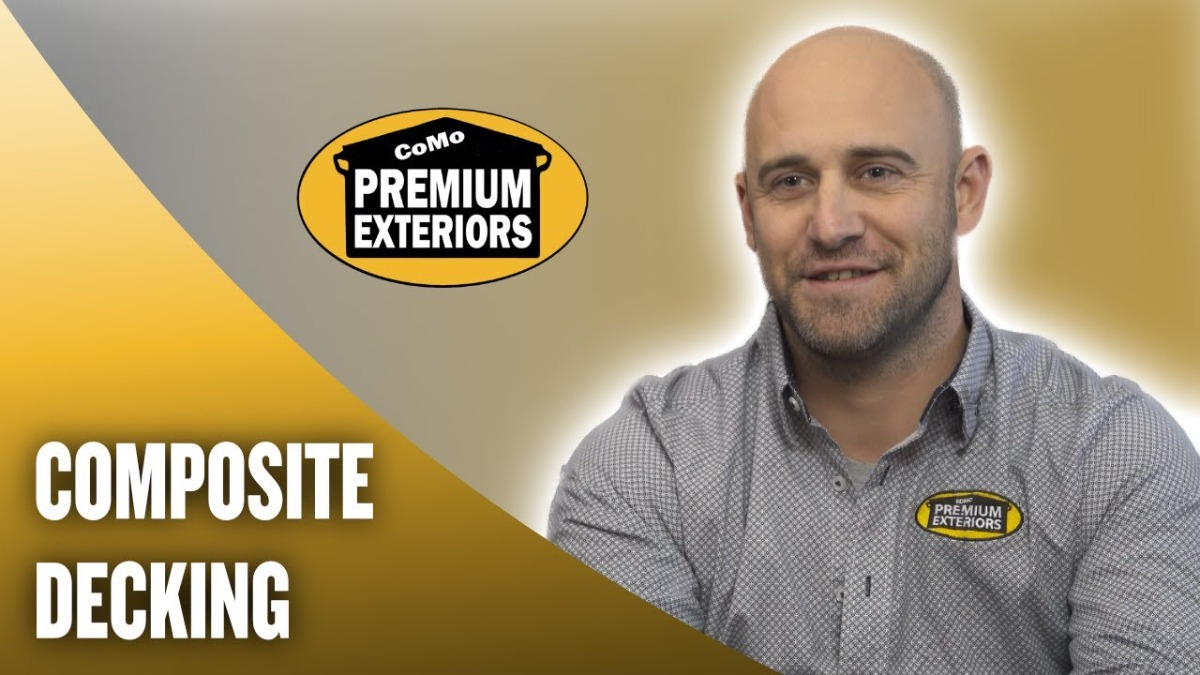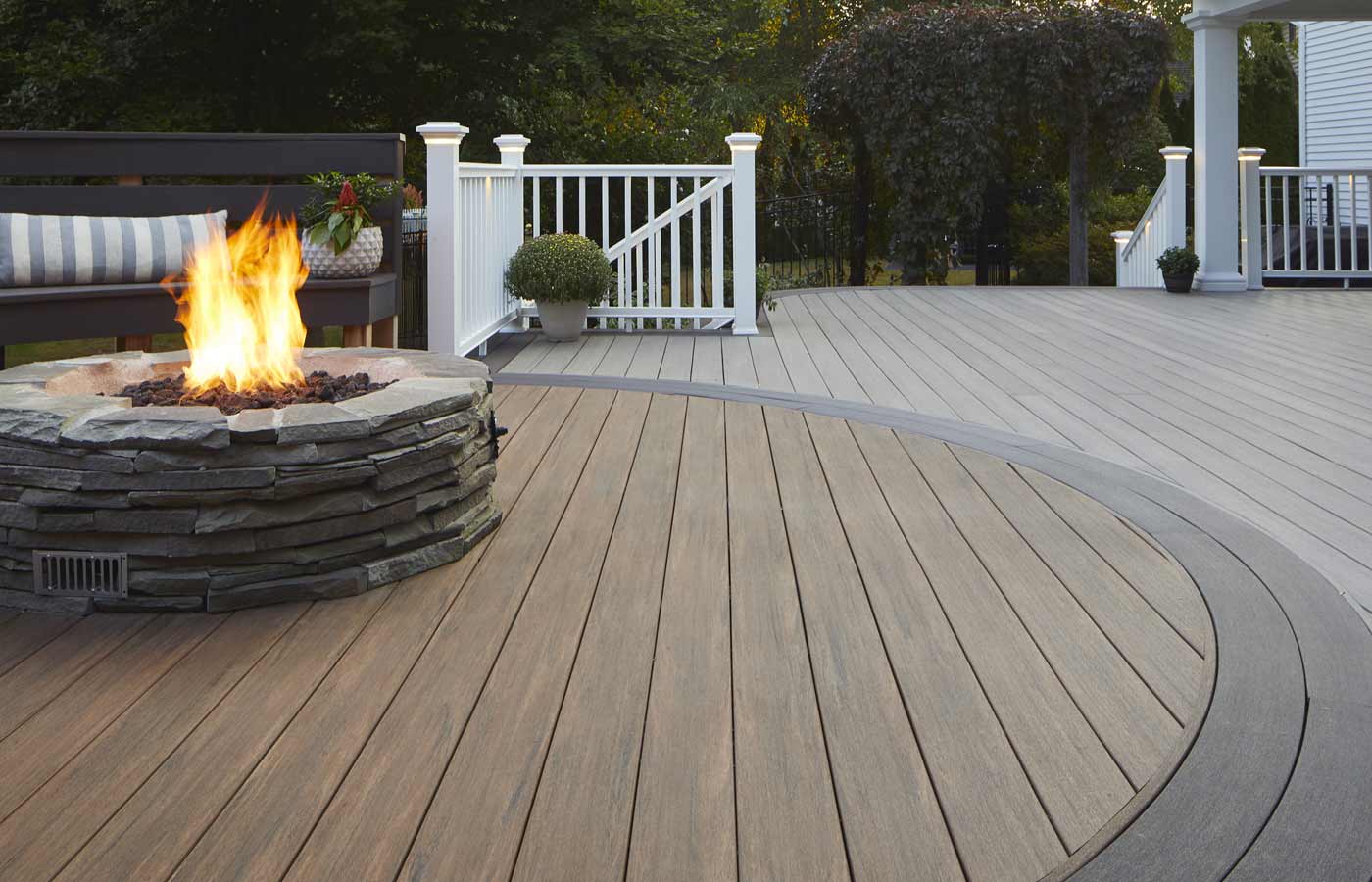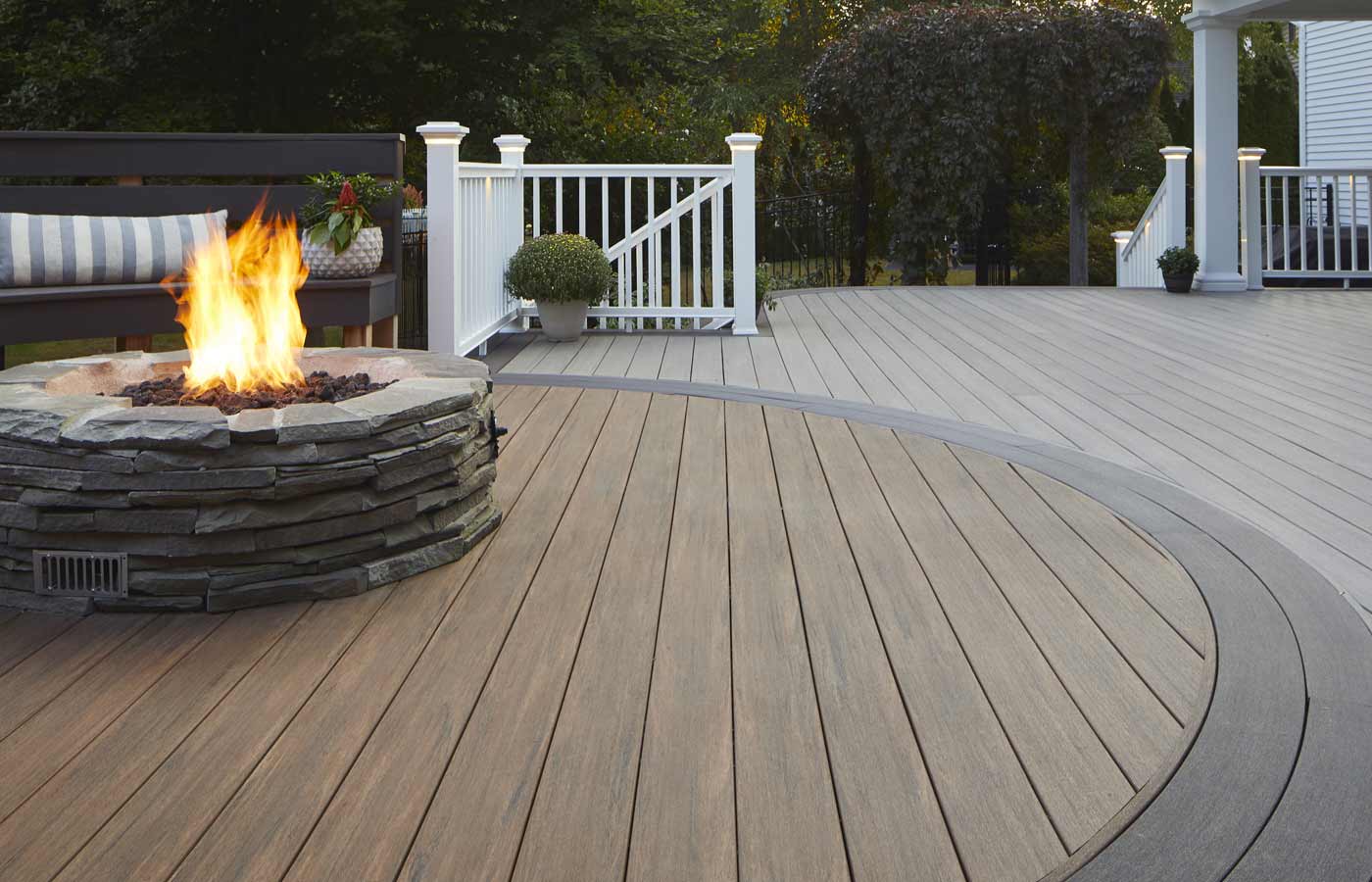Top Composite Deck Choices: Find Your Ideal Low-Maintenance Outdoor Space
Imagine creating a beautiful outdoor space that requires minimal maintenance and lasts for decades. A composite deck offers homeowners the opportunity to do just that. With superior durability and performance compared to traditional wood, composite decking is an investment that pays off in the long run. In this guide, we’ll explore the world of composite decks and help you find your ideal low-maintenance outdoor space.
Key Takeaways
- Composite decking offers superior performance, durability and low maintenance compared to traditional wood options.
- Choose from capped or uncapped composite boards for your outdoor space based on slip resistance needs and research materials used, color options, price etc. when selecting a brand.
- Composite decking is environmentally friendly with minimal upkeep requirements resulting in long term savings of time & money.
Understanding Composite Decking
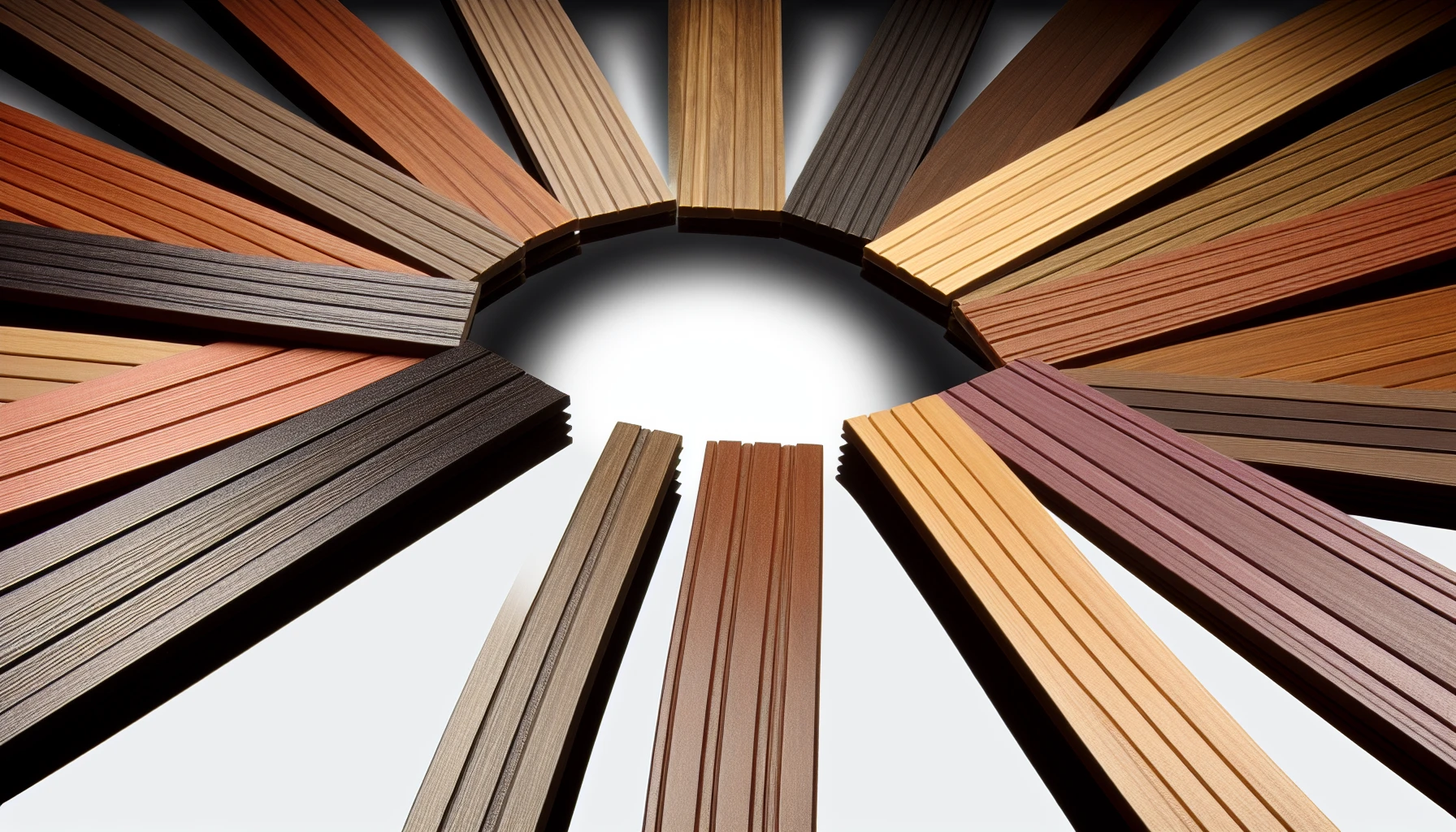
Composite decking boards in a variety of colors and styles
Composite materials have become increasingly popular in outdoor decking because of their superior performance and durability compared to traditional wood options. Some advantages of composite decking include:
- Enduring the elements and resisting moisture
- Low maintenance requirements
- Resistance to fading, staining, and scratching
- Long lifespan
- Environmentally friendly, as many composite decking materials are made from recycled materials
These benefits make composite decking a preferred choice over traditional lumber, including pressure treated lumber and pressure-treated wood.
With so many benefits to composite decking, it’s no wonder homeowners are making the switch. But what exactly goes into these materials, and what advantages do they provide?
Composite Decking Materials
Composite decking is crafted from a blend of wood fibers and plastic polymers, resulting in a durable and low-maintenance product. The wood particles included can range from sawdust to wood chips and wood fiber pieces. Meanwhile, the plastic component is often derived from recycled sources, contributing to the material’s sustainability and performance. With a variety of composite decking products available, homeowners can find the perfect solution for their outdoor living spaces.
One key feature of composite decking is the protective capping, which is a layer on top of the composite material that offers superior moisture and weathering protection, ensuring that your deck endures for many years. This cap also protects the boards from UV rays and erosion, keeping your deck looking fresh and vibrant for the life of the product.
Advantages of Composite Decking
When compared to traditional wood decking, composite decking offers several benefits that make it an attractive choice. For starters, composite decks are resistant to rotting and warping, ensuring a longer lifespan and less maintenance. Additionally, composite materials are more resistant to insects and moisture than traditional wood, making them a safer option for your family and the environment.
Aesthetically, composite decking offers a more uniform look and a variety of patterns that can be chosen to suit your personal style. With a wide range of colors and finishes available, composite decking allows homeowners to create a beautiful outdoor space that complements their home and landscape.
Types of Composite Deck Boards
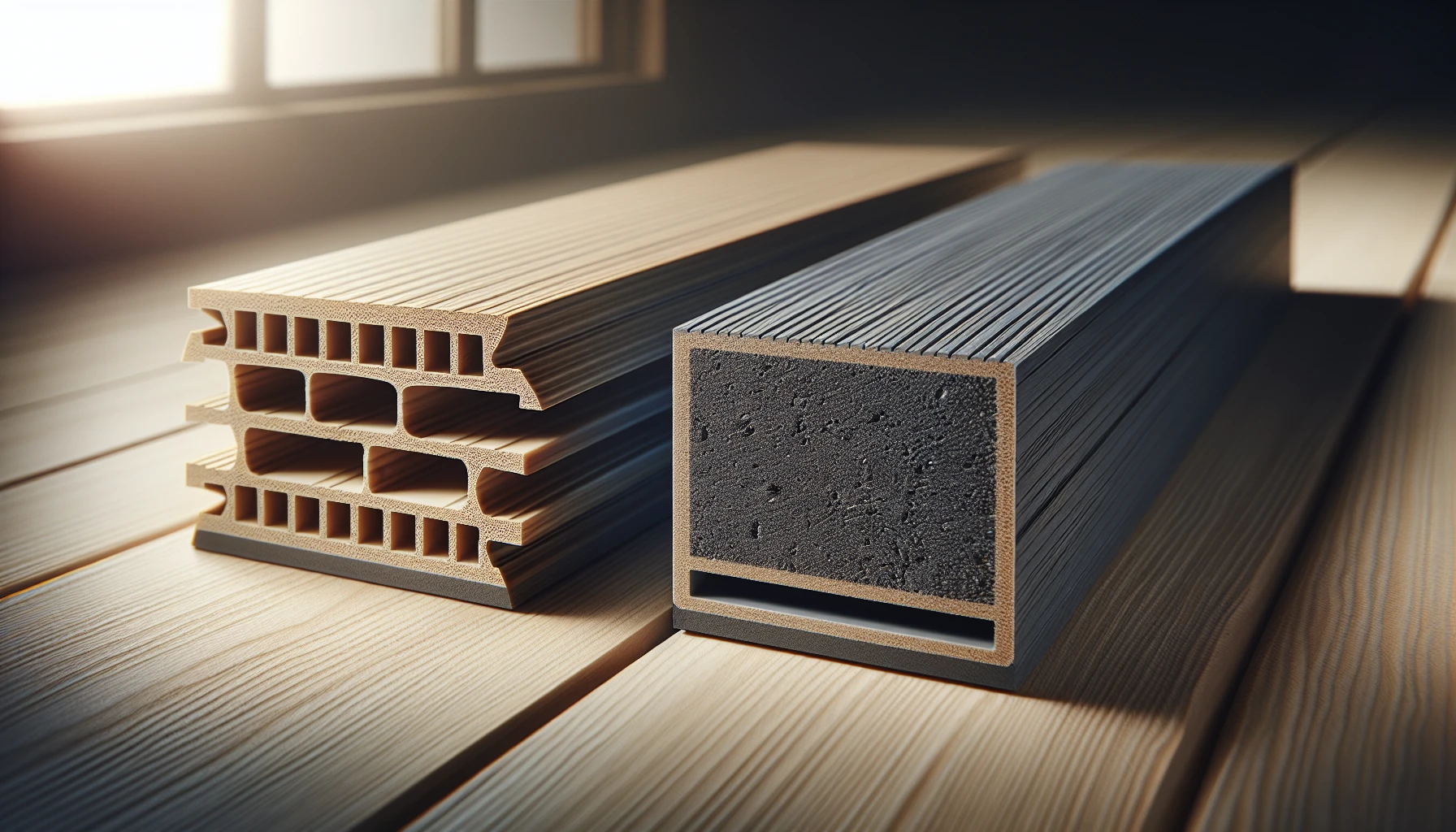
Comparison of capped and uncapped composite deck boards
Understanding the two primary varieties of composite deck boards, capped and uncapped, is necessary when selecting composite decking. Knowing the differences between these two types will help you make an informed decision on which option is best suited for your needs and preferences.
Capped Composite Decking
Capped composite decking is a type of decking material that features a traditional composite wood/plastic core with a durable polymer protective shell. This protective shell offers several benefits, including:
- Increased durability
- Prevention of fading, staining, scratching, and mold growth
- Low-maintenance requirements
- Long-lasting performance
Overall, capped composite decking is a great option for those looking for a durable and low-maintenance decking material.
Capped composite decking materials consist of a blend of wood and plastic, with the wood particles commonly sourced from sawmills and woodworking operations. The plastic element is typically derived from recycled sources, further contributing to the sustainable nature of capped composite decking.
Uncapped Composite Decking
Uncapped composite decking is a type of composite decking without a protective cap on the surface. As the first-generation version of composite decking, it may be more susceptible to fading, staining, and other forms of damage when compared to capped composite decking. However, uncapped decking may have a higher slip resistance, making it a viable option for areas around pools or hot tubs.
The materials used in uncapped composite decking typically consist of a blend of wood fiber and plastic. Though uncapped composite decking has its benefits, it may have some drawbacks such as lower resistance to moisture, stains, and UV compared to capped composite decking. It is essential to weigh these factors when considering uncapped composite decking for your outdoor space.
Leading Composite Decking Brands
Choosing the right composite decking brand from the numerous options in the market can be quite a challenge. Some of the most sought-after composite decking brands are:
- Trex
- TimberTech
- Fiberon
- Cali Bamboo
- CertainTeed
Each of these brands offers unique features and benefits that cater to different preferences and requirements.
Brand Features and Benefits
Many top composite decking brands, such as Trex, TimberTech, and Fiberon, offer a range of decking options, including fiberon decking, ensuring that there’s a perfect match for every homeowner’s style and budget. These brands boast unbeatable performance, low maintenance requirements, outstanding value, and highly attractive aesthetics, making them the top choices for composite decking.
Each brand offers distinct features that cater to different needs. For example, TimberTech decks can be heat-bent into elegant, curved shapes, offering a range of unexpected design possibilities. Additionally, TimberTech’s decking materials are designed to replicate the look of natural wood while remaining cooler under the sun, making them an excellent choice for hotter climates.
Choosing the Right Brand for Your Needs
Consider factors like the materials used, durability, color options, and price to choose the right composite decking brand for your specific needs. It’s also important to research consumer reports and evaluations of different brands to assess their performance and durability in your particular climate.
Consulting with experts and professionals in the decking industry can also provide valuable insight on which brand to choose. Ultimately, selecting the right brand comes down to personal preferences and requirements, and it’s essential to compare brands and gather as much information as possible before making a decision.
Composite Decking Colors and Styles
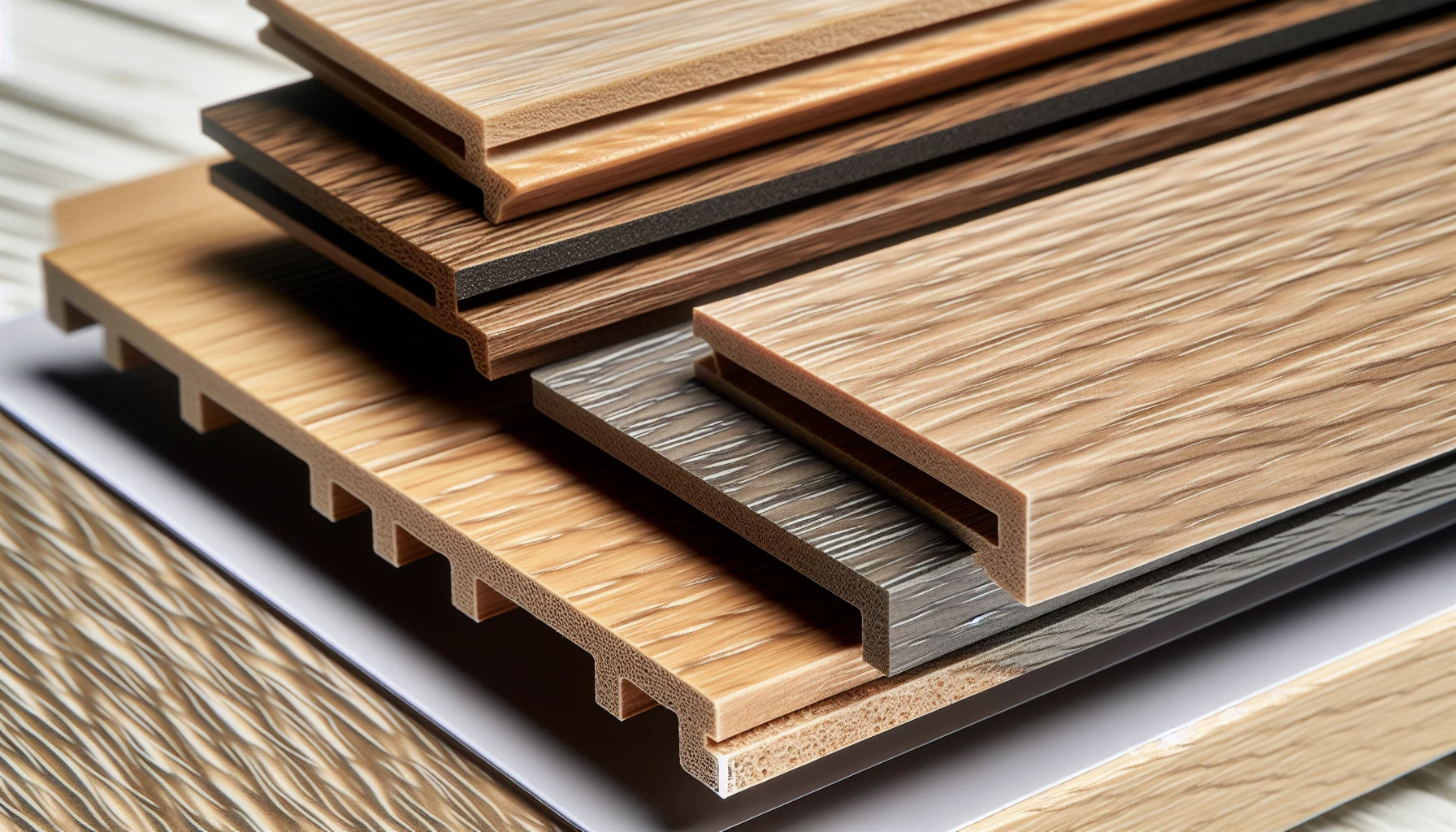
Wood-look composite decking samples
Composite decking offers a wide variety of colors and styles to choose from, allowing homeowners to customize their outdoor space to their liking. Some popular composite decking colors include warm and natural browns, shades of gray, and various tones of tan. The choice of color can greatly impact the overall aesthetics of your deck, so it’s important to consider how the color will complement the surrounding environment.
Wood-Look Composites
Wood-look composite decks are designed to replicate the appearance of real wood, featuring a wood-effect finish that emulates the knots and texture of natural wood. These decks are composed of a combination of wood fibers and recycled plastic, providing the aesthetic of wood with the strength and low-maintenance benefits of composite materials.
Popular brands for wood-look composite decking products include:
- TimberTech
- Cali Bamboo
- DuraLife
- CertainTeed
- Trex
These brands offer a range of colors, textures, and styles that resemble the beauty of natural wood while providing the durability and performance benefits of composite materials.
Unique and Trendy Designs
Composite decking allows homeowners to create unique and trendy designs that stand out from traditional wood decking. Some examples of distinctive and fashionable patterns employed in composite decking include deck board arrangements such as decking line. To get a better idea of these designs, consider requesting a decking sample:
- Simple single-width patterns
- Picture frame deck patterns
- Vibrant pinstripe boards
- Dynamic diagonal designs
- Intricate inlays
In addition to the wide range of patterns available, composite decking can also be customized and shaped for unique designs. By exploring different deck patterns and finishes, homeowners can create one-of-a-kind outdoor spaces that showcase their personal style and elevate the overall aesthetic of their home.
Installation and Maintenance of Composite Decks

Installation process of composite decking
Ensuring the longevity and performance of your composite deck requires proper installation and maintenance. Although composite decking requires less maintenance than traditional wood decking, it’s still important to follow the recommended installation process and perform routine upkeep to keep your deck looking its best.
Installation Process
The installation process for composite decking typically includes several key steps such as protecting the frame from rot, fastening start clips, and attaching the decking boards. With the right power tools and basic DIY carpentry skills, homeowners can learn how to install composite decking independently, or they can choose to hire a professional installer for an additional cost.
The average timeframe for composite decking installation depends on the size and complexity of the project, with most installations taking several days to a week to complete. For more detailed instructions and advice, consult comprehensive step-by-step guides and videos available online.
Minimal Maintenance Requirements
Minimal maintenance requirement compared to traditional wood decking is one of the key benefits of composite decking. To maintain a composite deck, homeowners should sweep away debris regularly and clean the deck with a mild soap, water, and brush every 3-6 months to eliminate dirt and soil.
While composite decking is more resistant to moisture and stains than traditional wood, it’s still important to perform regular maintenance to ensure the longevity and beauty of your deck. By following these simple steps, homeowners can keep their composite deck looking pristine and ready for outdoor entertaining.
Cost Considerations for Composite Decking
Considering both the initial investment and the long-term value of the product is important when thinking about composite decking. Although composite decking may have a higher upfront cost compared to traditional wood decking, the reduced maintenance requirements and longer lifespan make it a worthwhile investment in the long run.
Initial Investment
Depending on the brand and type of material used, the initial investment for composite decking typically ranges from $15 to $36 per square foot. While this may seem more expensive than traditional wood decking, which ranges from $4 to $25 per square foot, the durability and low maintenance of composite decking often make it a more cost-effective option in the long run.
It’s essential to consider the following factors when calculating the initial investment for a deck:
- Size and design of the deck
- Type and quality of materials used
- Labor and permits required
- Complexity of the deck corners and picture framing
By comparing these factors, homeowners can make an informed decision about the most suitable composite decking option for their budget and needs.
Long-Term Savings
Due to its reduced maintenance costs compared to traditional wood decking, composite decking offers long-term savings. Some benefits of composite decking include:
- Longer lifespan
- Minimal upkeep required
- Cost-effective
- Time-efficient option for homeowners
The average lifespan of a composite deck can range from 10 to 30 years, depending on the type of composite material used and the maintenance carried out. With proper installation and maintenance, some composite decks may even last a lifetime. This extended lifespan of composite decking decreases the need for replacement and reduces the overall environmental impact.
Environmental Impact of Composite Decking
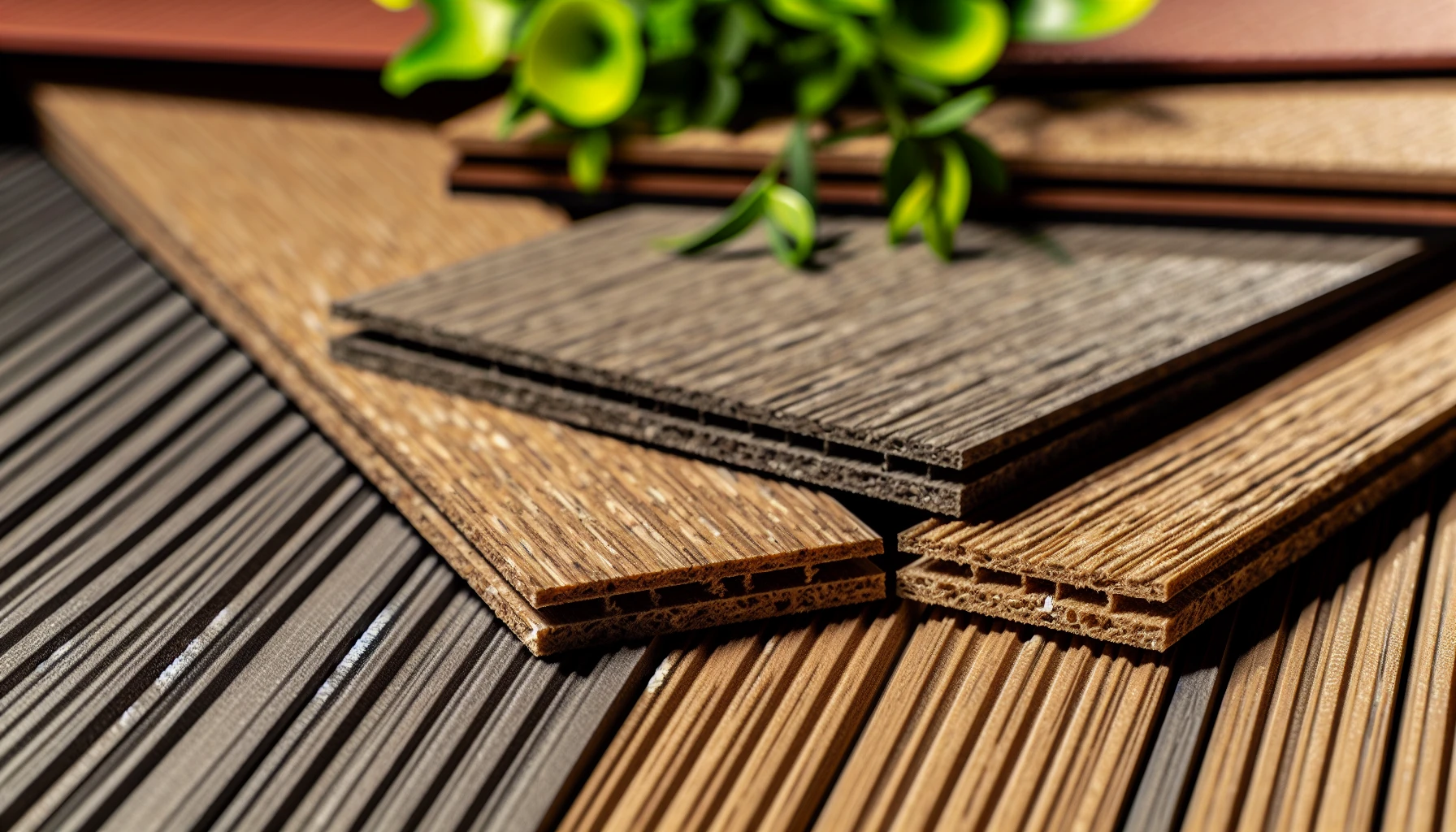
Sustainable composite decking materials
For many homeowners, the environmental impact of composite decking is an important consideration. Compared to traditional wood decking, which has been linked to deforestation in fragile ecosystems, composite decking is a more sustainable choice.
Often made from a blend of wood particles and recycled plastic, composite decking materials contribute to the product’s sustainability. By choosing composite decking or PVC decking, homeowners can enjoy the beauty of a natural wood look while minimizing the environmental impact associated with traditional wood decking and recycled wood.
Summary
In conclusion, composite decking offers a wide range of benefits for homeowners seeking a low-maintenance, durable, and sustainable outdoor space. With various styles, colors, and brands to choose from, there’s a perfect composite deck for every home and budget. By understanding the materials, installation process, maintenance requirements, and cost considerations, homeowners can make an informed decision and enjoy a beautiful, long-lasting outdoor space for years to come.
Frequently Asked Questions
How much does a 20 x20 composite deck cost?
A 20’x20′ composite deck typically costs between $16,000 and $32,000 to build, including substructure.
Is composite decking worth the money?
Composite decking offers greater durability and low maintenance compared to wood, making it a worthwhile investment for many homeowners. Its range of benefits, such as fade, scratch, and insect resistance, should be considered when weighing up the costs.
Which is better Trex or composite decking?
Trex decking material is one of the strongest and longest lasting decking materials on the market, and is highly resistant to fading, staining, scratching and mildew. It’s also easily maintained, only requiring an occasional cleaning with soap and water, making it a superior choice compared to traditional composite decking.
What are the common problems with composite decking?
Common problems with composite decking include improper framing, mold and mildew, inability to be repainted, lack of real wood look and increased cost.
What is the average lifespan of a composite deck?
The average lifespan of a composite deck is 10 to 30 years, depending on the material and maintenance.
About The Author
Elias Abadi
Owner
Elias, the founder of CoMo Premium Exteriors, has steered the company to become a leading exterior renovation firm in Mid-Missouri, emphasizing quality and customer-centric values. A Columbia resident since age 10, he is an ardent Mizzou athletics supporter. Outside of work, Elias enjoys family time, attending his three sons’ sports activities, and engaging in outdoor pursuits like hiking, fishing, gardening, and hunting.
